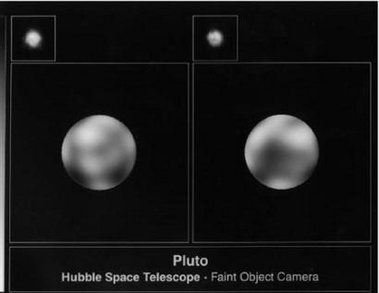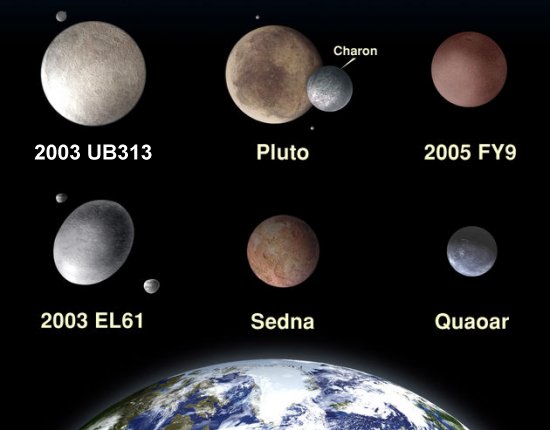
By WILLIAM J. KOLE, Associated Press Writer 43 minutes ago
PRAGUE, Czech Republic - Leading astronomers declared Thursday that Pluto is no longer a planet under historic new guidelines that downsize the solar system from nine planets to eight.
After a tumultuous week of clashing over the essence of the cosmos, the International Astronomical Union stripped Pluto of the planetary status it has held since its discovery in 1930. The new definition of what is — and isn't — a planet fills a centuries-old black hole for scientists who have labored since Copernicus without one.
Although astronomers applauded after the vote, Jocelyn Bell Burnell — a specialist in neutron stars from Northern Ireland who oversaw the proceedings — urged those who might be "quite disappointed" to look on the bright side.
"It could be argued that we are creating an umbrella called 'planet' under which the dwarf planets exist," she said, drawing laughter by waving a stuffed Pluto of Walt Disney fame beneath a real umbrella.
"Many more Plutos wait to be discovered," added Richard Binzel, a professor of planetary science at the Massachusetts Institute of Technology.
The decision by the prestigious international group spells out the basic tests that celestial objects will have to meet before they can be considered for admission to the elite cosmic club.
For now, membership will be restricted to the eight "classical" planets in the solar system: Mercury, Venus, Earth, Mars, Jupiter, Saturn, Uranus and Neptune.
Much-maligned Pluto doesn't make the grade under the new rules for a planet: "a celestial body that is in orbit around the sun, has sufficient mass for its self-gravity to overcome rigid body forces so that it assumes a ... nearly round shape, and has cleared the neighborhood around its orbit."
Pluto is automatically disqualified because its oblong orbit overlaps with Neptune's.
Instead, it will be reclassified in a new category of "dwarf planets," similar to what long have been termed "minor planets." The definition also lays out a third class of lesser objects that orbit the sun — "small solar system bodies," a term that will apply to numerous asteroids, comets and other natural satellites.
Experts said there could be dozens of dwarf planets catalogued across the solar system in the next few years.
NASA said Thursday that Pluto's demotion would not affect its US$700 million New Horizons spacecraft mission, which earlier this year began a 9 1/2-year journey to the oddball object to unearth more of its secrets.
"We will continue pursuing exploration of the most scientifically interesting objects in the solar system, regardless of how they are categorized," Paul Hertz, chief scientist for the science mission directorate, said in a statement.
The decision on Pluto at a conference of 2,500 astronomers from 75 countries was a dramatic shift from just a week ago, when the group's leaders floated a proposal that would have reaffirmed Pluto's planetary status and made planets of its largest moon and two other objects.
That plan proved highly unpopular, splitting astronomers into factions and triggering days of sometimes combative debate that led to Pluto's undoing. In the end, only about 300 astronomers cast ballots.
Now, two of the objects that at one point were cruising toward possible full-fledged planethood will join Pluto as dwarfs: the asteroid Ceres, which was a planet in the 1800s before it got demoted, and 2003 UB313, an icy object slightly larger than Pluto whose discoverer, Michael Brown of the California Institute of Technology, has nicknamed Xena.
Charon, the largest of Pluto's three moons, is no longer under consideration for any special designation.
Brown, who watched the proceedings from Cal Tech, took Thursday's vote in stride — even though his discovery won't be christened a planet.
"UB313 is the largest dwarf planet. That's kind of cool," he said.
___
Pluto Demoted: No Longer a Planet in Highly Controversial Definition
Author Robert Roy Britt
Senior Science Writer
SPACE.com 1 hour, 23 minutes ago
UPDATED 11:17 a.m.
Capping years of intense debate, astronomers resolved today to demote Pluto in a wholesale redefinition of planethood that is being billed as a victory of scientific reasoning over historic and cultural influences. But already the decision is being hotly debated.
Officially, Pluto is no longer a planet.
"Pluto is dead," said Caltech researcher Mike Brown, who spoke with reporters via a teleconference while monitoring the vote. The decision also means a Pluto-sized object that Brown discovered will not be called a planet.
"Pluto is not a planet," Brown said. "There are finally, officially, eight planets in the solar system."
The vote involved just 424 astronomers who remained for the last day of a meeting of the International Astronomical Union (IAU) in Prague.
"I'm embarassed for astornomy," said Alan Stern, leader of NASA's New Horizon's mission to Pluto and a scientist at the Southwest Research Institute. "Less than 5 percent of the world's astronomers voted."
"This definition stinks, for technical reasons," Stern told SPACE.com. He expects the astronomy community to overturn the decision. Other astronomers criticized the definition as ambiguous.
The resolution
The decision establishes three main categories of objects in our solar system.
* Planets: The eight worlds from
* Mercury to Neptune.Dwarf Planets: Pluto and any other round object that "has not cleared the neighborhood around its orbit, and is not a satellite."
* Small Solar System Bodies: All other objects orbiting the
Sun.
Pluto and its moon Charon, which would both have been planets under the initial definition proposed Aug. 16, now get demoted because they are part of a sea of other objects that occupy the same region of space. Earth and the other eight large planets have, on the other hand, cleared broad swaths of space of any other large objects.
"Pluto is a dwarf planet by the ... definition and is recognized as the prototype of a new category of trans-Neptunian objects," states the approved resolution.
Dwarf planets are not planets under the definition, however.
"There will be hundreds of dwarf planets," Brown predicted. He has already found dozens that fit the category.
Contentious logic
The vote came after eight days of contentious debate that involved four separate proposals at the group's meeting in Prague.
The initial proposal, hammered out by a group of seven astronomers, historians and authors, attempted to preserve Pluto as a planet but was widely criticized for diluting the meaning of the word. It would also have made planets out of the asteroid Ceres and Pluto's moon Charon. But not now.
"Ceres is a dwarf planet. it's the only dwarf planet in the asteroid belt," Brown said. "Charon is a satellite."
The category of "dwarf planet" is expected to include dozens of round objects already discovered beyond Neptune. Ultimately, hundreds will probably be found, astronomers say.
The word "planet" originally described wanderers of the sky that moved against the relatively fixed background of star. Pluto, discovered in 1930, was at first thought to be larger than it is. It has an eccentric orbit that crosses the path of Neptune and also takes it well above and below the main plane of the solar system.
Recent discoveries of other round, icy object in Pluto's realm have led most astronomers to agree that the diminutive world should never have been termed a planet.
'A farce'
Stern, in charge of the robotic probe on its way to Pluto, said the language of the resolution is flawed. It requires that a planet "has cleared the neighborhood around its orbit." But Earth, Mars, Jupiter and Neptune all have asteroids as neighbors.
"It's patently clear that Earth's zone is not cleared," Stern told SPACE.com. "Jupiter has 50,000 trojan asteroids," which orbit in lockstep with the planet.
Stern called it "absurd" that only 424 astronomers were allowed to vote, out of some 10,000 professional astronomers around the globe.
"It won't stand," he said. "It's a farce."
Stern said astronomers are already circulating a petition that would try to overturn the IAU decision.
Owen Gingerich, historian and astronomer emeritus at Harvard who led the committee that proposed the initial definition, called the new definition "confusing and unfortunate" and said he was "not at all pleased" with the language about clearing the neighborhood.
Gingerich also did not like the term "dwarf" planet.
"I thought that it made a curious linguistic contradiction," Gingerich said in a telephone interview from Boston (where he could not vote). "A dwarf planet is not a planet. I thought that was very awkward."
Gingerich added: "In the future one would hope the IAU could do electronic balloting."
Years of debate
Astronomers have argued since the late 1990s, however, on whether to demote Pluto. Public support for Pluto has weighed heavily on the debate. Today's vote comes after a two-year effort by the IAU to develop a definition. An initial committee of astronomers failed for a year to do so, leading to the formation of the second committee whose proposed definition was then redefined for today's vote.
Astronomers at the IAU meeting debated the proposals right up to the moment of the vote.
Caltech's Mike Brown loses out in one sense. The Pluto-sized object his team found, called 2003 UB313, will now be termed a dwarf planet.
"As of today I have no longer discovered a planet," he said. But Brown called the result scientifically a good decision.
"The public is not going to be excited by the fact that Pluto has been kicked out," Brown said. "But it's the right thing to do."
Textbooks will of course have to be rewritten.
"For astronomers this doesn't matter one bit. We'll go out and do exactly what we did," Brown said. "For teaching this is a very interesting moment. I think you can describe science much better now" by explaining why Pluto was once thought to be a planet and why it isn't now. "I'm actually very excited."
------------
Pluto’s Demotion is Well Deserved and Long Overdue
Posted on August 24, 2006 @ 08:06:54 EDT
Author Robert Roy Britt
You might love Pluto, but since 1930 it has been a glaring (if hard to see) error in astronomical decision-making.
The vote today to boot Pluto off the list of planets gives the word “planet” some scientific meaning.
Astronomers stared down public opinion and made the right decision. Now they have a big job: to stay the course in the face of immediate and future outcry from the public or from any astronomers would would revise the main points of the decision.
-----
BC-Pluto Demoted, 6th Ld-Writethru,0929
Pluto demoted as astronomers approve new definition for planets
Eds: SUBS grafs 13-14 pvs to UPDATE with quote from teacher,
NASA saying no effect on mission.
AP Photos LA101-102
AP Graphic
By WILLIAM J. KOLE
Associated Press Writer
PRAGUE, Czech Republic (AP) … For decades, it's been
confused with a cartoon dog and ridiculed as a puny poser. Now
Pluto, the solar system's consummate cling-on, has suffered
its worst humiliation: It's not even a planet anymore.
After a tumultuous week of clashing over the essence of the
cosmos, leading astronomers Thursday stripped Pluto of the
planetary status it has held since its discovery in 1930. The
new definition of what is … and isn't … a planet fills a
centuries-old black hole for scientists who have labored since
Copernicus without one.
The historic vote by the International Astronomical Union
officially shrinks Earth's neighborhood from the traditional
nine planets to eight.
But the scientists made clear they're as sentimental as
anyone else about the ninth rock from the sun.
Jocelyn Bell Burnell … a specialist in neutron stars from
Northern Ireland who oversaw the proceedings in Prague … urged
those who might be quite disappointed‘ to look on the bright
side.
It could be argued that we are creating an umbrella called
'planet' under which the dwarf planets exist,‘ she said,
drawing laughter by waving a stuffed Pluto of Walt Disney fame
beneath a real umbrella. Later, she hugged the doll as she
stood at the dais.
Many more Plutos wait to be discovered,‘ added Richard
Binzel, a professor of planetary science at the Massachusetts
Institute of Technology.
The decision by the prestigious international group spells
out the basic tests that celestial objects will have to meet
before they can be considered for admission to the elite
cosmic club.
For now, membership will be restricted to the eight
classical‘ planets in the solar system: Mercury, Venus,
Earth, Mars, Jupiter, Saturn, Uranus and Neptune.
Much-maligned Pluto … named for the God of the underworld …
doesn't make the grade under the new rules for a planet: a
celestial body that is in orbit around the sun, has sufficient
mass for its self-gravity to overcome rigid body forces so
that it assumes a ... nearly round shape, and has cleared the
neighborhood around its orbit.‘
Pluto is automatically disqualified because its oblong
orbit overlaps with Neptune's.
Instead, it will be reclassified in a new category of
dwarf planets,‘ similar to what long have been termed minor
planets.‘ The definition also lays out a third class of lesser
objects that orbit the sun … small solar system bodies,‘ a
term that will apply to numerous asteroids, comets and other
natural satellites.
Experts said there could be dozens of dwarf planets
catalogued across the solar system in the next few years …
handing the world's school teachers a challenge.
Neil Crumpton, a science teacher at Mountfitchet High
School in Stansted Mountfitchet, north of London, called the
announcement very exciting.‘
To be honest, this has been brewing for a while. Pluto has
always been a bone of contention among astronomers because of
the odd way it orbits the sun,‘ Crumpton said. For a start,
we'll have to change all the mnemonics we use to teach
children the lineup of the planets. But Pluto has not
disappeared and it doesn't hurt children to know about it.‘
NASA said Thursday that Pluto's demotion would not affect
its $700 million New Horizons spacecraft mission, which
earlier this year began a 9•-year journey to the oddball
object to unearth more of its secrets.
We will continue pursuing exploration of the most
scientifically interesting objects in the solar system,
regardless of how they are categorized,‘ Paul Hertz, chief
scientist for the science mission directorate, said in a
statement.
The decision at a conference of 2,500 astronomers from 75
countries was a dramatic shift from just a week ago, when the
group's leaders floated a proposal that would have reaffirmed
Pluto's planetary status and made planets of its largest moon
and two other objects.
That plan proved highly unpopular, splitting astronomers
into factions and triggering days of sometimes combative
debate that led to Pluto's undoing. In the end, only about 300
astronomers cast ballots.
Now, two of the objects that at one point were cruising
toward possible full-fledged planethood will join Pluto as
dwarfs: the asteroid Ceres, which was a planet in the 1800s
before it got demoted, and 2003 UB313, an icy object slightly
larger than Pluto whose discoverer, Michael Brown of the
California Institute of Technology, has nicknamed Xena.‘
Charon, the largest of Pluto's three moons, is no longer
under consideration for any special designation.
Brown was pleased by the decision. He had argued that Pluto
and similar bodies didn't deserve planet status, saying that
would take the magic out of the solar system.‘
UB313 is the largest dwarf planet. That's kind of cool,‘
he said.
But as it all sank in, he added: Deep down inside, I know
this is the right thing to do. It's sad. As of today, I have
no longer discovered a planet.‘
………
AP Science Writer Alicia Chang in Los Angeles contributed
to this story.
………
On the Net:
International Astronomical Union, www.iau.org
AP-ES-08-24-06 1158EDT





















